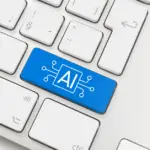Not many people have been talking about artificial intelligence (AI) in learning and development (L&D) circles over the last few years. Then, ChatGPT happened.
Now, there seems to be a nonstop stream of new tools and growing buzz “about the potential of AI technology to shape what workplace learning is moving forward,” according to JD Dillon, founder of LearnGeek and the Chief Learning Architect at Axonify.
However, for many learning practitioners, that buzz is less about excitement and more about anxiety around the unknown. Specifically, what does this mean for those of us currently doing jobs or even tasks that AI-enabled tech could potentially replace in the near future?
During this informative webinar, JD adeptly answered that question and more because of his personal experience and a firm conviction about what the future looks like. There is no denying that people’s lives, their experience of work and experience in life, are being altered by technology like never before.
“We’ve had these moments over the last 20 years where there are these fundamental shifts, and sometimes they were felt iteratively and slowly over time. Sometimes, they happen a little bit more quickly and a little more loudly.” – JD Dillon
JD believes we are in the middle of a transformational moment in history. One that will not only shape the future of learning and development but is the beginning of a fundamental change in how we all live and work.
What is Artificial Intelligence?
A respected speaker, author, podcaster, and AI enthusiast, JD has a front-row seat to the rapid evolution of AI, making him a uniquely qualified voice and leader on the subject. That is why one of the most noteworthy moments for attendees was the point where he shared his definition of a technology that has so many people taking sides.
Simply referred to as AI, artificial intelligence is “the theory and development of computer systems that can perform tasks that typically require human intelligence.”
Objectively, it isn’t difficult to see why there is so much consternation. It doesn’t take a lot of imagination to see there are virtually endless possible uses for AI, most of which are positive. Yet, there are a lot of negative possibilities, too.
This underscores the importance for organizations to start having discussions now and work toward implementing guard rails before it is too late. As fast as tools and technologies are advancing today, without action, there will come a point where the technology will be driving the train.
Read JD Dillon’s Book: The Modern Learning Ecosystem
4 Things You Need to Know About AI
Regarding AI, there are no definable limits on how the technology can be applied. Like the early days of Apple’s App Store, it is like the Wild West, with everyone blindly racing to build their own app.
Eventually, the various niche ways AI is being leveraged today will become consolidated into multi-faceted toolsets with a clear purpose.
Until that day comes, there are four inevitable truths we, as learning professionals, must understand about AI:
- We do not get to decide if we are going to use AI.
- We don’t know quite where we are going. We are in transition.
- AI will redefine workplace learning (see #1).
- Values are more important than features.
#1 We do not get to decide if we are going to use AI
Like it or not, the AI revolution is in its infancy. Designers and developers are just starting to scratch the surface of what they can do.
For example, the so-called generative AI applications are what is feeding the hype machine right now. These tools primarily create text, video, images, and audio content. Some can also handle real-time content translation, note-taking, summarizing, and captioning content.
The next wave of applications starting to appear is utilizing AI to help us automate workflows.
To illustrate this truth another way, JD points out that people view these tools as a separate technology or feature. AI has already been part of our lives for many years.
You experience it when it is used to make streaming suggestions or recommend route changes in your navigation software.
Eventually, artificial intelligence will be embedded in every platform, device, and tool set we use. Processes and tasks we handle today will be taken over by AI-powered actions and routines like:
- Creating a template in PowerPoint.
- Generating content from a simple search request.
- Pulling attendance reports from an LMS.
- Enrolling learners in the right courses based on their training history or job role.
All you will have to do is just ask. Many of these examples are weeks or months away, not years.
L&D departments must start making smart choices about their digital strategy and asking questions to understand how their organization’s technology transformation will impact current and future employees.
“L&D should take advantage of this opportunity and not ‘let it happen to us’ in the way that the internet, social media, and mobile technology caused us quickly to fall behind and play catch up.” – JD Dillon
So, while you may not get to decide if you will use AI, it is not too late to help determine when, where, and how it will be used.
#2 We are in transition
When implementing AI-driven solutions in your organization, the decisions made in the beginning are too important to sit idly by while they happen.
L&D professionals need to make sure their voices are heard. Otherwise, like so many times before, someone else will decide how we will use this new technology.
Your first step as an L&D practitioner is to learn as much as possible about artificial intelligence. Then, spend time leaning into curation.
Look around your organization and ask questions about how information is shared and stored.
“It is important to take the time as an L&D team to have conversations, learn together, and make time for our own learning and development.” – JD Dillon
Ask yourself, “Will a bot be able to find and retrieve what it needs?” If the answer is “no,” formulate a plan to analyze and curate your content silos before it feeds your AI-powered applications.
During this transition period, JD emphasized the importance of “stepping back and looking at some of those foundational things we’ve done when it comes to measurement, curation, and analysis to make sure that we’re ready to be able to take advantage of technology.”
The last thing you want to happen is to “get access to this really cool tech” only to realize your organization lacks the necessary resources to take advantage of it.
#3 AI will redefine workplace learning
AI is more than just another tool to help us design, develop, or manage learning. Artificial intelligence will not only help consolidate a lot of digital experiences in the workplace. It will accelerate that consolidation.
“In today’s world, L&D typically sits between the people who know and the people who need,” JD explained.
“In tomorrow’s world, there may come a role for technology to help learners access what they need directly, supplied by AI, moderated, and organized by L&D professionals.”
L&D often plays the middle person or comes in as an expert for one part of a more extensive training program, but when AI comes into the picture, it will take over the role of the middle person.
That will allow the learning function to become the connection point, facilitating between those who need to know or learn and those who have the information, from subject matter experts (SMEs) to stakeholders.
“We’re not the heroes of this story. We’re not Batman in learning and development. We’re Alfred. We’re the person in the chair who’s making sure people can get access to the things they need.” – JD Dillon
JD reiterates his point and adds, “While it looks like it’s shoving us (L&D) into the background. I believe this is a meaningfully good thing as long as we inform this conversation.”
AI allows learning teams to support more people and help solve more problems by giving learners access to systems, channels, and technologies that enable them to do their best work every day.
#4 Values are more important than features
L&D professionals tend to get distracted by what technology can do, but with AI, it’s not about the technology. The focus should be on how people get the help they need to do their jobs and how easily they can solve their problems.
Put another way, if we base our decisions on AI technologies because of their features, we will be focused on all the bells and whistles instead of prioritizing what we value most.
“It is critical for us to work with our peers within our organizations, to determine what are the guiding values we’re going to use to make decisions when it comes to how AI is applied and how AI informs the experience of work.” – JD Dillon
To that end, JD shared the guiding principles he walks through when talking with an organization about creating its technology strategy.
There are five core values he believes have the power to help frame AI conversations in a meaningful way:
- Strategic: We are here to solve problems, not implement platforms.
- Transparent: We must ensure people understand how technology impacts their work experience. People have to believe the technology is reliable and trust what it produces.
- Equitable: Technology allows us to level the playing field, foster equity, and allow everyone the opportunity to learn equally.
- Seamless: Tech should make work life easier, not more complex. We need to partner with the organization to understand what the digital experience of work is becoming so we can determine our role.
- Compliant: We must build our strategy to align with a patchwork of AI-related regulations internally and externally.
Whatever your organization’s criteria are, being consistent and staying true to those principles will determine how successful you are at implementing technology that positively shapes people’s workplace experience.
Focus on Building Trust
No matter what audience you support within your organization, you should focus on building trust.
Involve learners in your process before they start to question or doubt. It is essential for people at every level of your company to feel like they are part of the conversation and their input is valued.
Likewise, people need to trust the data and resources stored in your company’s various information bases are updated, accurate, and authorized.
Then, when employees search for information and are presented with a list of AI-generated links, they can trust the articles, job aids, courses, and other knowledge are approved by the legal team and vetted by SMEs and stakeholders.
Final Thoughts
We may not know exactly where artificial intelligence will ultimately take us, but we can already see how it is forcing some companies to change how they operate.
“I think we’re in that next moment in terms of a transformational shift in how we relate to technology and how technology helps us do our job.” – JD Dillon
Regardless of what role you play in your organization’s AI transformation strategy, you need to be actively involved in the most important conversations within your organization so crucial decisions aren’t being made for you but by you.
Looking for more? Watch highlights from the Not Another AI Webunar! 4 Things You Wish You Knew About Artificial Intelligence or read JD Dillon’s book, The Modern Learning Ecosystem.
- 10shares
- LinkedIn3
- Twitter2
- Facebook0
- Love This5









